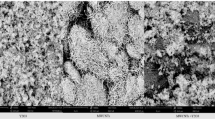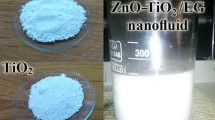Abstract
This research deals with experimental studies on thermal conductivity variation of Al2O3 and TiO2 hybrid nanofluids with water as the base fluid. In addition, Al2O3 and TiO2 nanofluid mixtures were used for evaluation. The prepared samples were tested for determination of thermal conductivity at room temperature as well as at different temperatures. A comprehensive regression analysis was accomplished to link the experimental data sets with volume fractions for all prepared new fluids, as well as with temperature variation. The experimental results were finally linked to an evaluation of Mo number and heat transfer efficiency for possible solar energy uses. Results indicated that the hybrid nanofluids possess upper thermal conductivity if related to water and can successfully replace it in heat transfer applications.









Similar content being viewed by others
Abbreviations
- d :
-
Diameter (m)
- n :
-
Empirical shape factor
- T :
-
Temperature (K)
- R 2 :
-
Accuracy of the fitted equations (–)
- u :
-
Estimated standard uncertainty (–)
- α :
-
Thermal diffusivity (m2 s−1)
- μ :
-
Dynamic viscosity (kg ms−1)
- φ :
-
Particle volume fraction (–)
- HTE:
-
Heat transfer efficiency
- f:
-
Base fluid
- hnf:
-
Hybrid nanofluid
- mass:
-
Refers to mass
- nf:
-
Nanofluid
- p:
-
Particle
- r:
-
Relative
- tot:
-
Total
- vol:
-
Refers to volume
References
Zyła G, Fal J. Viscosity, thermal and electrical conductivity of silicon dioxide–ethylene glycol transparent nanofluids: an experimental studies. Thermochim Acta. 2017;650:106–13.
Zyła G, Fal J, Estellé P. Thermophysical and dielectric profiles of ethylene glycol based titanium nitride (TiN–EG) nanofluids with various size of particles. Int J Heat Mass Transf. 2017;113:1189–99.
Maxwell CA. Treatise on electricity and magnetism. Oxford: Clarendon Press; 1881.
Hamilton RL, Crosser OK. Thermal conductivity of heterogeneous two component systems. I&EC Fundam. 1962;1:187–91.
Wasp FJ. Solid–liquid slurry pipeline transportation. Berlin: Transactions on Techniques; 1977.
Maiga SEB, Palm SJ, Nguyen CT, Roy G, Galanis N. Heat transfer enhancement by using nanofluids in forced convection flows. Int J Heat Fluid Flow. 2005;26:530–46.
Buongiorno J. Convective transport in nanofluids. J Heat Transf. 2006;128:240–50.
Li CH, Peterson GP. Experimental investigation of temperature and volume fraction variations on the effective thermal conductivity of nanoparticle suspensions (nanofluids). J Appl Phys. 2006;99:0843141–8.
Mintsa HA, Roy G, Nguyen CT, Doucet D. New temperature dependent thermal conductivity data for water-based nanofluids. Int J Therm Sci. 2009;48:363–71.
Timofeeva EV, Gavrilov AN, McCloskey JM, Tolmachev YV. Thermal conductivity and particle agglomeration in alumina nanofluids: experiment and theory. Phys Rev. 2007;76:061203.
Avsec J, Oblak M. The calculation of thermal conductivity, viscosity and thermodynamic properties for nanofluids on the basis of statistical nanomechanics. Int J Heat Mass Transf. 2007;50:4331–41.
Sharma KV, Sarma PK, Azmi WH, Mamat R, Kadirgama K. Correlations to predict friction and forced convection heat transfer coefficients of water based nanofluids for turbulent flow in a tube. Int J Microscale Nanoscale Therm Fluid Transp Phenom (Spec Issue Heat Mass Transf Nanofluids). 2012;3(4):1–25.
Chandrsekar M, Suresh S, Srinivasan R, Chandra Bose A. New analyatical models to investigate thermal conductivity of nanofluids. J Nanosci Nanotechnol. 2009;9:533–8.
Duangthongsuk W, Wongwises S. Measurement of temperature-dependent thermal conductivity and viscosity of TiO2–water nanofluids. Exp Therm Fluid Sci. 2009;33(4):706–14.
Dawood HK, Mohammed HA, Che Sidik NA, Munisamy KM. Numerical investigation on heat transfer and friction factor characteristics of laminar and turbulent flow in an elliptic annulus utilizing nanofluid. Int Commun Heat Mass Transf. 2015;66:148–57.
Mahendran M, Lee GC, Sharma KV, Shahrani A, Bakar RA. Performance of evacuated tube solar collector using water-based titanium oxide nanofluid. J Mech Eng Sci. 2012;3:301–10.
Azmi WH, Sharma KV, Sarma PK, Mamat R, Najafi G. Heat transfer and friction factor of water based TiO2 and SiO2 nanofluids under turbulent flow in a tube. Int Commun Heat Mass Transf. 2014;59:30–8.
Sarkar J, Ghosh P, Adil A. A review on hybrid nanofluids: recent research, development and applications. Renew Sustain Energy Rev. 2015;43:164–77.
Asadi A, Asadi M, Rezaniakolaei A, Rosendahl LA, Afrand M, Wongwises S. Heat transfer efficiency of Al2O3-MWCNT/thermal oil hybrid nanofluid as a cooling fluid in thermal and energy management applications: an experimental and theoretical investigation. Int J Heat Mass Transf. 2018;117:474–86.
Huminic G, Huminic A. Hybrid nanofluids for heat transfer applications—a state-of-the-art review. Int J Heat Mass Transf. 2018;125:82–103.
Nabil MF, Azmi WH, Abdul Hamid K, Mamat R, Hagos FY. An experimental study on the thermal conductivity and dynamic viscosity of TiO2–SiO2 nanofluids in water: ethylene glycol mixture. Int Commun Heat Mass Transf. 2017;86:181–9.
Akilu S, Baheta AT, Sharma KV. Experimental measurements of thermal conductivity and viscosity of ethylene glycol-based hybrid nanofluid with TiO2–CuO/C inclusions. J Mol Liq. 2017;246:396–405.
Ghadikolaei SS, Yassari M, Sadeghi H, Hosseinzadeh Kh, Ganji DD. Investigation on thermophysical properties of TiO2–Cu/H2O hybrid nanofluid transport dependent on shape factor in MHD stagnation point flow. Powder Technol. 2017;322:428–38.
Charab AA, Movahedirad S, Norouzbeigi R. Thermal conductivity of Al2O3 + TiO2/water nanofluid: model development and experimental validation. Appl Therm Eng. 2017;119:42–51.
Hamid KA, Azmi WH, Nabil MF, Mamat R. Experimental investigation of nanoparticle mixture ratios on TiO2–SiO2 nanofluids heat transfer performance under turbulent flow. Int J Heat Mass Transf. 2018;118:617–27.
Abdul Hamid K, Azmi WH, Nabil MF, Mamat R, Sharma KV. Experimental investigation of thermal conductivity and dynamic viscosity on nanoparticle mixture ratios of TiO2–SiO2 nanofluids. Int J Heat Mass Transf. 2018;116:1143–52.
Verma SK, Tiwari AK. Progress of nanofluid application in solar collectors: a review. Energy Convers Manag. 2015;100:324–46.
Mahian O, Kianifar A, Kalogirou SA, Pop I, Wongwises S. A review of the applications of nanofluids in solar energy. Int J Heat Mass Transf. 2013;57:582–94.
Raj P, Subudhi S. A review of studies using nanofluids in flat-plate and direct absorption solar collectors. Renew Sustain Energy Rev. 2018;84:54–74.
Gupta HK, Agrawal GD, Mathur J. Investigations for effect of Al2O3-H2O nanofluid flow rate on the efficiency of direct absorption solar collector. Case Stud Therm Eng. 2015;5:70–8.
Delfani S, Karami M, Behabadi MAA. Performance characteristics of a residential type direct absorption solar collector using MWCNT nanofluid. Renew Energy. 2016;87:754–64.
Chen M, He Y, Zhu J, Wen D. Investigating the collector efficiency of silver nanofluids based direct absorption solar collectors. Appl Energy. 2016;181:65–74.
Minea AA, El-Maghlany WM. Influence of hybrid nanofluids on the performance of parabolic trough collectors in solar thermal systems: recent findings and numerical comparison. Renew Energy. 2018;120:350–64.
Table Curve 3D, Jardell Scientific.
Akhgar A, Toghraie D. An experimental study on the stability and thermal conductivity of water-ethylene glycol/TiO2-MWCNTs hybrid nanofluid: developing a new correlation. Powder Technol. 2018;338:806–18.
Prasher D, Song J, Wang P, Phelan P. Measurements of nanofluid viscosity and its implications for thermal applications. Appl Phys Lett. 2006;89:133108.
Moldoveanu GM, Minea AA, Iacob M, Ibanescu C, Danu M. Experimental study on viscosity of stabilized Al2O3, TiO2 nanofluids and their hybrid. Thermochim Acta. 2018;659:203–12.
Mouromtseff IE. Water and forced-air cooling of vacuum tubes. Proc IRE. 1942;30:190–205.
Minea AA, Moldoveanu M. Studies on Al2O3, CuO, and TiO2 water-based nanofluids: a comparative approach in laminar and turbulent flow. J Eng Thermophys. 2017;26:30–291.
Asadi M, Asadi A, Aberoumand S. An experimental and theoretical investigation on the effects of adding hybrid nanoparticles on heat transfer efficiency and pumping power of an oil-based nanofluid as a coolant fluid. Int J Refrig. 2018;89:83–92.
Simons RE. Comparing heat transfer rates of liquid coolants using the Mouromtseff number. Electron Cool. 2006;12:12.
Timofeeva EV. Nanofluids for heat transfer—potential and engineering strategies. In: Ahsan, A, editor. Two phase flow, phase change and numerical modeling. Chap 7. Intech Open; 2011. https://doi.org/10.5772/22158.
Xu J, Bandyopadhyay K, Jung D. Experimental investigation on the correlation between nano-fluid characteristics and thermal properties of Al2O3 nano-particles dispersed in ethylene glycol–water mixture. Int J Heat Mass Transf. 2015;94:262–8.
Acknowledgements
The authors would like to acknowledge that this research was possible with the support of the COST action CA 15119: Nanouptake—Overcoming Barriers to Nanofluids Market Uptake.
Author information
Authors and Affiliations
Corresponding author
Rights and permissions
About this article
Cite this article
Moldoveanu, G.M., Minea, A.A., Huminic, G. et al. Al2O3/TiO2 hybrid nanofluids thermal conductivity. J Therm Anal Calorim 137, 583–592 (2019). https://doi.org/10.1007/s10973-018-7974-4
Received:
Accepted:
Published:
Issue Date:
DOI: https://doi.org/10.1007/s10973-018-7974-4




